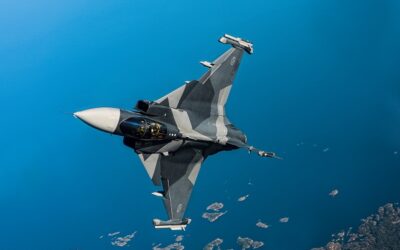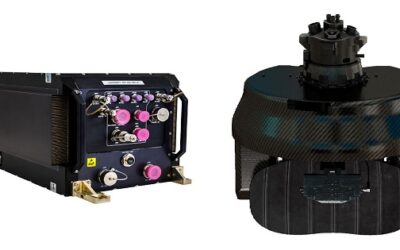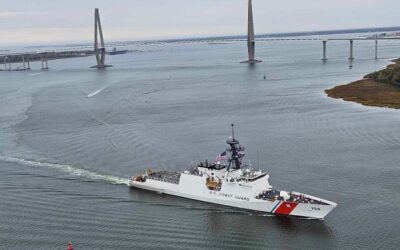A brief overview of the main challenges and key cooperation areas in the Arctic
At Sea Air Space 2018, MONCh attended the Global Arctic Panel, which aimed to discuss the main challenges facing the Arctic region at present and the ways in which Arctic nations and neighbours are tackling them.
Major General Ilkka Laitinen, Deputy Chief of the Finnish Border Guard, kicked off the panel by introducing the Arctic Coast Guard Forum (ACGF), which Finland chairs this year. After indicating that this was an initiative brought about by two countries, namely Russia and the US, and includes Canada as well as the five Nordic states (Sweden, Finland, Denmark, Norway and Iceland), he noted that although this is a relatively new structure (2015) it has already achieved a number of operational results.
Rear Admiral John A. Okon, Commander Naval Meteorology and Oceanography Command pointed out that the US Navy (USN) has been operating in the Arctic since 1958, primarily with undersea assets, and today the USN meets the current challenges with its undersea and naval aviation assets. As the Arctic becomes more ice-free, the violent weather and violent ocean phenomena are becoming more prevalent and as such global and atmospheric models are the core of what the Command does to understand and characterise the region: the Global ocean forecast system; the Naval Global environmental model; and, the Ice model. All models run independently but by year’s end they will be coupled with National Oceanographic Atmospheric administration under the Earth systems prediction capability. This is important because data on the region is very limited and partnership with other nations is key in gathering as much information as possible.
Rear Admiral Timothy Gallaudet, Assistant Secretary of Commerce for Ocean and Atmosphere, Acting Under Secretary of Commerce for Oceans and Atmosphere, National Oceanic and Atmospheric Administration, started by pointing out that he thinks the 21st century will be known as the ‘Maritime Age’ as a result of the rapid expansion of maritime activity in the past 25 years. The Arctic is a perfect example of this with the Northern Sea Route open for commerce. He continued by sharing four topic areas that are particularly of interest for improving capabilities. Firstly, increasing partnerships such as public and private partnerships, to expand capabilities in a very cost effective way, and programmes such as the National Oceanographic Partnership Programme that promotes research partnerships in all earth sciences to advance Arctic understanding. Secondly, exploring a wide array of unmanned systems, such as the undersea gliders, surface wave gliders and aerial vehicles in order to do surveys in a more efficient way. Thirdly, safety is a main concern to ensure the economic growth of the region. Fourthly, economic growth through the Blue Economy, that is, leveraging everything coastal areas have to offer by surveying – for instance at present only five per cent of the exclusive economic zone around the coast of Alaska has been surveyed.
Commissioner Jeffery Hutchinson of the Canadian Coast Guard (CCG) indicated that the Arctic region will be a high- and low-end tensions region. For the CCG this means partnership is the core value when working in the Arctic. In particular, the CCG is currently in a fundamental mind-shift to go into a deeper partnership with the people that live in the Arctic; this means that it will now be “by the North, from the North, for the North”, and no longer a presence that is projected from the South into the North.
Mr Michael Emerson, Director, Marine Transportation Systems, Senior Arctic Policy Advisor, USCG started his intervention by indicating that the USCG is the lead federal presence in the Arctic, however both the national strategy and the USCG strategy are over five years old now and are due for overhaul – the new USCG strategy will be published next month. The year 2017 was a record year for low ice and for shipping activity in the region, and was also an exciting year as the US worked together with the Russians on a joint proposal they submitted to the International Maritime Organisation and based on ten years of research in the Barent Sea looking at a number of key issues, including the future responsibilities of the coast guards in the region in terms of safety. They came to an agreement on a recommended shipping route, which has been approved in February, and on three areas to be avoided that respect the environment, which should be approved in May and be implemented in the coming year. The USCG has a lot of assets but they are old, and needs six ice breakers (three heavy and three medium).
The Q&A session raised a number of interesting points. In relation to the importance of partnerships, the panellists noted that they will be key not only in sharing information but also in working with the industry to be more cost and time efficient in the missions that will be taking place in the region. The relationship with the indigenous cultures in the region will also become a prominent feature in the future of cooperation in the Arctic as it will be crucial to leverage their knowledge. Panellists also discussed the importance of communication technologies, which are currently sorely missing in the Arctic region thus making navigation even more difficult. This will include, for instance, the US, Canada and Finland working together to establish AIS virtual buoys. In this sense, partnering with nations that are not Polar countries but that are Arctic aspiring nations will also be essential in leveraging knowledge from different areas. For instance in 2017 there were nine research vessels in the summer from different nations, all working on gathering different information which would be key to missions in the region. The panellists also pointed out that they will also begin crowdsourcing bathymetric information in something that is known as ‘science diplomacy’. Finally, the USCG shared a few initial points of their new forthcoming strategy, which will include: increasing relationships with the industry to support commerce in the area, increase aids to navigation, working with indigenous representatives to leverage their knowledge and, finally, supporting the national strategy by increasing awareness as well as modernising governance.
AV
























